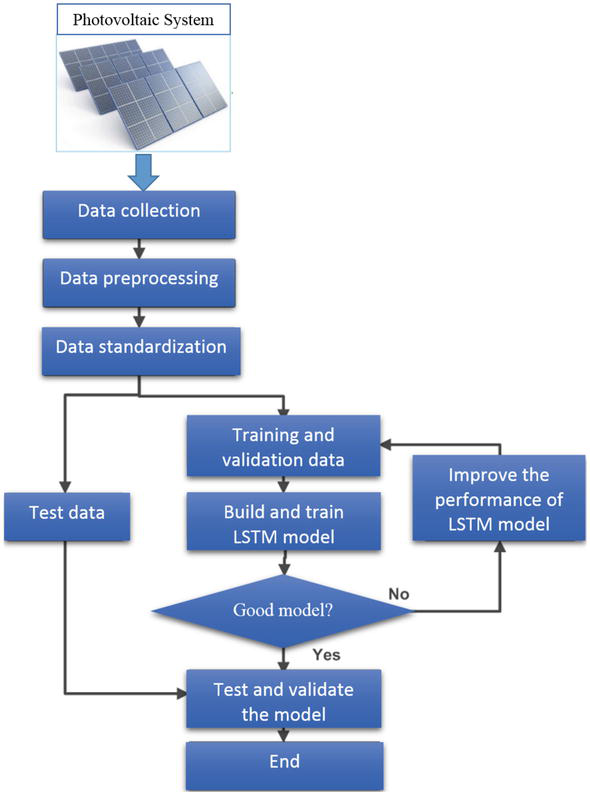
Fig: Solar Power Forecasting Using Machine Learning
The increasing prevalence of renewable energy in the electric energy
grid has highlighted the need for accurate forecasting to facilitate
effective power system planning, management, and operations.
However, the intermittent and variable nature of renewable energy
data makes this a challenging task. To enhance the reliability of
renewable energy forecasts the Long Short-Term Memory (LSTM) model
has gained attention as a potential machine learning technique that
can identify nonlinear characteristics and high-level invariant
structures in data. This study aimed to forecast solar irradiance
using both Random Forest and LSTM networks, with LSTM demonstrating
superior accuracy in terms of Mean Squared Error (MSE) and r2_score.
Furthermore, the study also explored the direct forecasting of solar
power using Machine Learning models such as Random Forest and
Gradient Boosting Regressing models. However, Solar energy depends
heavily on local weather conditions, and as a result, typically
hundreds of models are built, which need site and season specific
training. The model maintenance and management also become a tedious
job with such a large number of models. Therefore, this study
proposes to generalize solar power forecasting models using a
Bi-LSTM model and transfer-learning technique, a novel approach that
has yet to be explored in the literature.
Keywords:
Solar Power, Machine Learning, LSTM, Forecasting, Renewable Energy,
Bi-LSTM, Transfer Learning
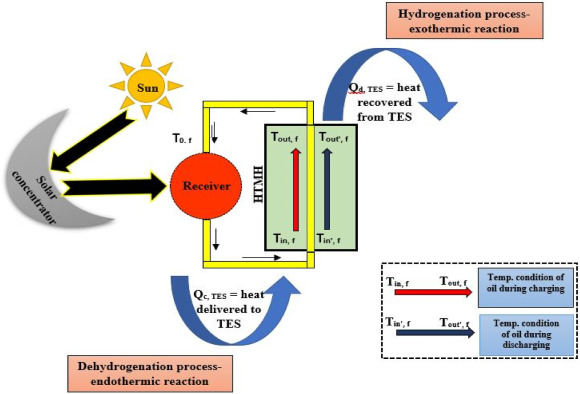
Fig: Receiver For Solar Bakery
The application of solar energy is getting attention nowadays. Hence, Baking is one of the main applications of solar thermal technology. The Indian market for bakery goods is expected to expand at a Compound Annual Growth Rate of 8.5% between 2021 and 2026. The study of the bakery process, temperature requirement, and energy requirement is necessary to design and develop of receiver for bakery purpose with the investigation of parameters like bakery quantity, optimization factor of solar oven, different shapes, number of glass panes, and inclination angle in order to improve the output of the receiver. A receiver with a conical shape, 2 glass panes, and a downward facing give minimum heat losses. Different receiver design has been reviewed in this study and experimental tests like a plate-based test, and water heating test performed on the current prototype have been discussed. The numerical 3-dimensional combined study of the natural convection is carried out for the basic model receiver having an open cavity using ANSYS fluent. Temperature and velocity contours have been plotted after using suitable boundary conditions and a meshing strategy. The constant wall temperature is considered 423K and the surface heat transfer coefficient obtained from the simulation is 4.4299 W/m2-K. The results have been validated and give very less percentage error of 2.14%. Keywords: Solar Energy, Bakery, Thermal Technology, Conical Receiver, Heat Transfer, ANSYS
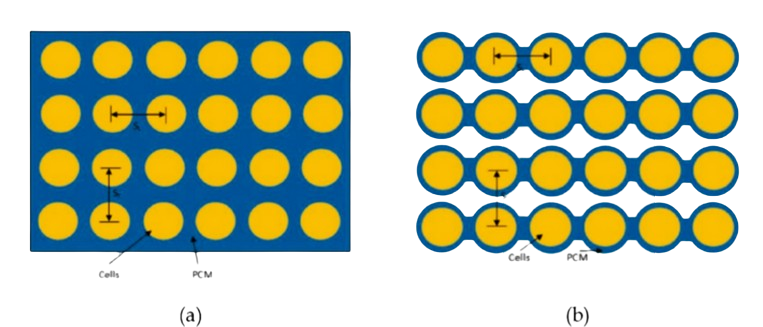
Fig: Co-gasification Process
The Lithium-ion batteries have become the ideal choice for a wide variety of applications including Electric Vehicles (EV) , portable hand tools, mobile phones all due to their superior energy density as well as relatively longer life span compared to other battery technologies. However, they have a tendency to easily overheat when charging or discharging at higher current rating. In many other battery types, it may be possible to use them without a BTMS, but it is highly dangerous to use lithium-ion batteries without any thermal management system. This report will take a look at the inner workings of a lithium-ion battery and then take a look at the conditions that cause the thermal runaway phenomenon and most of the critical thermal issues in the lithium-ion batteries. A brief discussion of some of the existing BTMS types will be reviewed. Keywords: Li-ion batteries, Electric Vehicles, Battery thermal management systems.
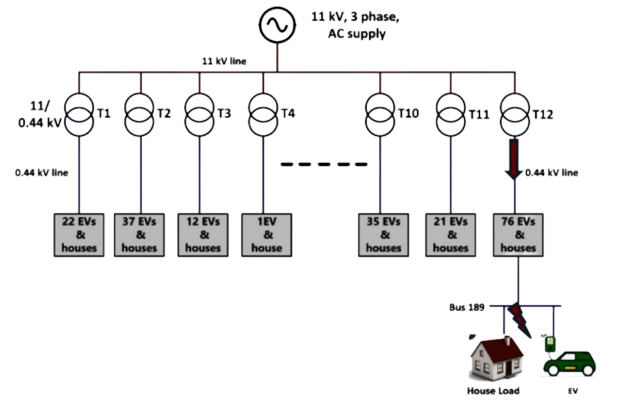
Fig: Block Diagram for simulated distribution system with EVs and DGs integration
Protection of traditional distribution systems is relatively easier as they are set up in a radial configuration with the primary source supplying power. The protection system incorporates various components like fuses, auto re-closers, overcurrent relays and circuit breakers. However, the integration of bidirectional power sources such as DGs and EVs can result in various protection challenges, like increasing short-circuit level of the system, change in power flow direction, loss of coordination within relays, protection blinding, sympathetic tripping, unsynchronised reclosing, etc. The study of the impact of EV penetration and DG integration is carried out in four different scenarios, namely Grid to Vehicle (G2V) unidirectional charging mode, G2V charging along with DG integration (G2V+DG), Vehicle to grid (V2G) bidirectional charging, and V2G charging along with DG integration (V2G+DG). The simulation study is carried out on a detailed dynamic model of a real-life distribution system of Delhi developed in DIgSILENT PowerFactory. The analysis of the obtained results facilitates the validation changes required in the existing protection system in response to changing scenarios in real-world distribution networks, such as the integration of DGs and the rise in EV adoption. Keywords: Electric Vehicles, Distributed Generation, Protection Systems, Distribution Networks, Grid Integration, Smart Grid
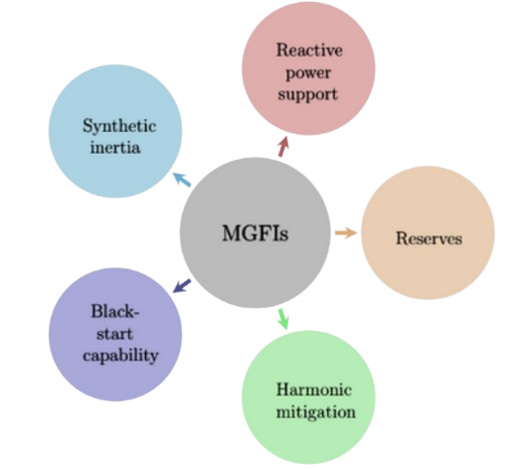
Fig: Capabilities of Multi-functional Grid Forming Inverters (MGFIs)
The penetration of inverter-based generation has risen exponentially due to environ-mental and economic reasons. Phasing out of synchronous generators can pose a potential threat for the grid, causing problems due to the low overload capacity, lack of inertia, etc., in inverters. Grid forming inverters have proved promising in filling these gaps, and hence, their deployment is slowly increasing across vast geographical boundaries. However, a number of such inverters spread out over large geographical regions give rise to complex control problems. Therefore, the challenge lies in the development of communication-less strategies to solve these issues. The work involves the development of advanced decentralized control strategies for grid forming inverters that improve steady state and transient responses in addition to power quality. Extensive simulations and experimental validations prove the efficacy of the proposed control strategies. Keywords: Grid Forming Inverters, Distributed Generation, Power Quality, Decentralized Control, Renewable Integration
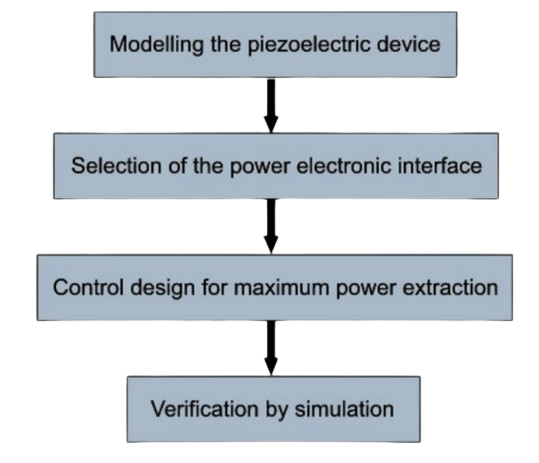
Fig: Flowchart of the process
Energy harvesting has emerged as a potential method for powering low-power devices like sensor nodes in wireless sensor networks and biomedical electronic implants. Currently, batteries are the main power source for such devices. Replacing or recharging these batteries located in difficult-to-access locations is time and cost intensive. Thus, using ambient energy or waste energy to recharge these batteries is seen as a reliable solution. The underlying principle is to capture and convert ambient energy to a useful form. Along with this, proper power conditioning is required to suit the load specifications. This study is based on the utilization of the piezoelectric effect for converting vibrational kinetic energy to electrical energy. A model of the piezoelectric device is developed. It is interfaced with a resonant inverter for maximum power extraction from the ambient source. Zero voltage switching is employed to reduce switching losses during inverter operation. Another DC-DC buck converter is used to supply power to the load as per its requirements. Keywords: Energy Harvesting, Piezoelectric, Power Electronics, Zero Voltage Switching, Resonant Inverter, DC-DC Converter
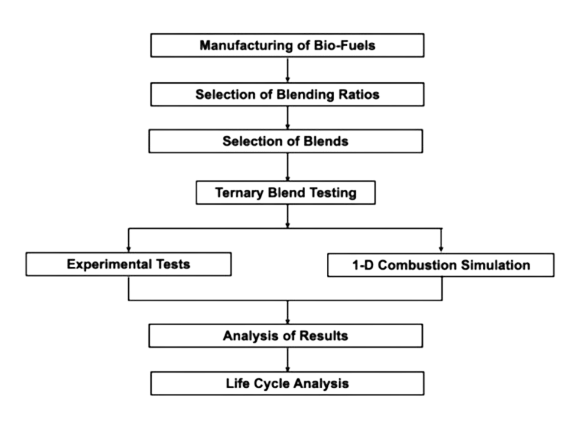
Fig: Process Flow for Selection of Alternate Fuel Blends
The Indian Navy is working towards having a Green Strike Group by the end of this decade in accordance with the National Bio-Fuel Policy and the Indian Navy Environment Conservation Roadmap (INECR). Therefore it has become imperative to identify and implement clean burning fuels without compromising on India's maritime dominance in the blue waters. The Indian Navy is presently using High Flash High Speed Diesel (HFHSD) for propulsion and power generation. Target of this project is to identify fuel blends (with bio-fuels) which may provide performance comparable to FSHSD whilst reducing emissions without undertaking any major modifications to the marine engines and associated shipboard systems. Ternary blends (FSHSD + Bio-Diesel + Bio-Ethanol) were arrived upon as the tentative solution towards countering the limitations of using standalone Bio-Diesel blends. Further, considering sustainability as one of the cornerstones for evaluation as per INECR, Used Cooking Oil (UCO) based Bio-Diesel and Bio-Ethanol (from waste food crops) are being used as the components of the targeted Ternary blend. The most suited blend will be selected based on experimental results of trials on test engines and 1-D combustion simulation. This blend will then be further assessed from the standpoint of shelf life and long term utility. Keywords: Alternative Fuels, Marine Diesel Engines, Bio-Diesel, Bio-Ethanol, Indian Navy, Combustion Simulation, Ternary Blends
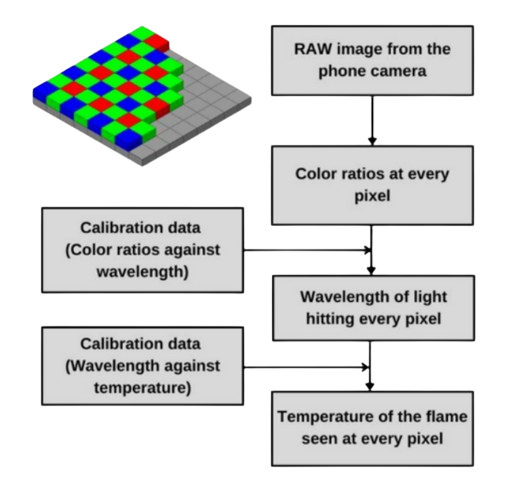
Fig: Block Diagram of the Implementation
Pyrometry is a crucial technique for measuring flame temperature in various applications such as furnaces, laboratories, and reaction energetics. Two-color pyrometry is a non-contact method that uses two different wavelengths of light to determine an object's temperature. Color ratio pyrometry, a subset of two-color pyrometry, uses the intensity ratio of two colors to calculate an object's temperature. The study explores the possibility of using a smartphone camera as a pyrometer, as it measures three wavelengths (Red, Green, and Blue). Three smartphones are used and calibrated with a monochromator to obtain the camera sensor's spectral response curves. These curves are used with power measurements to plot color ratio curves like R/G against the wavelength. Wavelength vs temperature curves are later obtained for each phone using a blackbody calibration furnace. The final product is a mobile application that inputs a raw image and outputs a detailed temperature analysis of the flame. The study also explores the possibility of creating common calibration data for all smartphones and using the Raspberry Pi (RPi) and its camera module as a pyrometer instead of a smartphone. Keywords: Pyrometry, Flame Temperature, Color Ratio, Smartphone Camera, Wavelength, Temperature Measurement
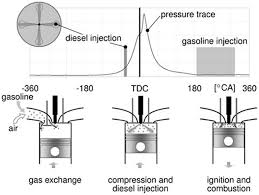
Fig: Machine Learning Model for RCCI Engine Control
Reactivity Controlled Compression Ignition (RCCI) is an attractive low temperature combustion (LTC) technology that exhibits potential for reducing nitrogen oxides (NOx), and soot emissions while simultaneously enhancing fuel conversion efficiency at certain engine operating conditions, compared to conventional diesel engines. Effective control of the maximum pressure rise rate (MPRR) is critical for the safe and efficient operation of RCCI engines at varying engine loads. This study employs a data-driven modeling (DDM) approach that utilizes a least square-support vector machines (SVM) algorithm to develop a linear parameter-varying (LPV) representation of MPRR, mid-point of combustion (CA50), and indicated mean effective pressure (IMEP) for RCCI combustion. The LPV model is integrated into a model predictive controller (MPC) to regulate CA50 and IMEP while constraining MPRR. The performance of the proposed controller is evaluated using closed-loop simulations, where a neural network model is trained, with data available in literature, to accurately predict CA50, IMEP, MPRR and cylinder pressure and temperature at the start of combustion (SOC). The trained neural network model achieved high prediction accuracy with R2 values greater than 0.9 for all features. The proposed DDM approach has the potential to enhance the control of RCCI combustion, leading to improved engine performance and reduced emissions. Keywords: RCCI Engine, Machine Learning, Predictive Control, SVM, Neural Networks, Emission Reduction, Combustion
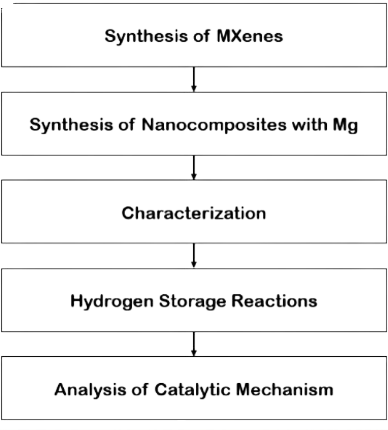
Fig: Block Diagram for Hydrogen Storage in Mxene Based Catalysts
In light of increasing environmental degradation and decline of nonrenewable energy sources over the last few decades, hydrogen fuel has been seen as a key alternative source of renewable energy. To attain the desired hydrogen economy, several materials for hydrogen storage have been developed. Magnesium hydride has become a hot spot in the research of hydrogen storage materials, due to its high theoretical hydrogen storage capacity and also high gravimetric and volumetric hydrogen capacities of ca. 7.6 wt.% and 111 g/L, respectively. However, the bottleneck to the wide applications of Magnesium hydride as a commercial source of hydrogen fuel is the slow kinetics of hydrogen de/absorption MXene, a novel 2D transition metal carbide has demonstrated the dual roles of storing hydrogen and enhancing the hydrogen evolution reactions of lightweight metal hydrides especially Magnesium Hydride. Therefore, two batches of TiC2Tx MXenes were prepared by adding 1 g of Titanium Aluminium Carbide powder to 10 mL of 40% HF-etchant and kept for stirring at room temperature for 36h and 24h. MXene and Mg nanocomposites were prepared by ball milling for 60h. This project provides insights into MXenes, their recent applications as potential materials for storing hydrogen, and as functional additives for enhancing the hydrogen reaction of Magnesium Hydride. Keywords: MXene, nanocomposites, Titanium Aluminium Carbide, Hydrogen storage,
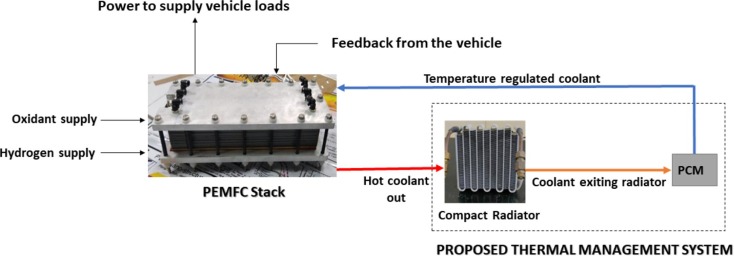
Fig: Energy Storage Technologies Overview
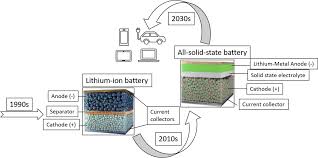
Fig: Energy Storage Technologies Overview
Lithium cobalt oxide (LCO) is a well-known cathode due to its distinctive structure and superior electrochemical relationship. However, electrochemical operation at a voltage of more than 4.5 V and at a high rate, a requirement of today's battery technology, LCO losses its structural stability and related battery safety. The LCO cathode has been coated with a thin layer of lithium cobalt manganese oxide (LiCo0.5Mn1.5O4, or LCMO), and synthesized using microwave-assisted heating. The as-prepared cathode structure revealed very less manganese (III) ion (Mn3+) diffusion into the LCO, which increased its lattice parameter and favored the Li-ion diffusion in the LCO cathode, enabling a faster cycling rate for longer periods. The full cell is fabricated using LCMO-coated LCO as a cathode and graphite as an anode. The n/p ratio was optimized to achieve superior full-cell performance. To demonstrate the practical relevance of the research, we developed a 2 Ah pouch cell. The as developed cathode material was used to fabricate all solid-state cell and its electrochemical characterization was carried out. The interface between Li metal and solid-state electrolyte was stabilized through lithiophilic and lithiophobic kind of gradient morphology. Keywords: Lithium Cobalt Oxide, High voltage cathode, Li-ion diffusion,lithium cobalt manganese oxide